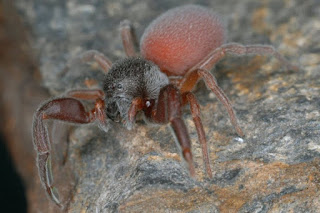Palpimanidae
Anisaedus levii
A spider in the family Palpimanidae
Palpimanidae is a family of spiders, known as palp-footed spiders. The family is fairly small; it includes about 130 described species of ground-dwelling spider in 15 genera.
Description
The most obvious features of the Palpimanidae are the front legs, which are disproportionately powerful and heavily sclerotised. The abdomen is round to oval, evenly sprinkled with short straight hairs that in some species are sufficiently dense to form a close-fitting coat, though most species look nearly smooth. Usually the cephalothorax is somewhat less obviously hairy. The abdomen is evenly rounded without conspicuous sculpting, and in many species is elongated into an olive shape twice as long as the cephalothorax, giving the spider a vaguely torpedo-shaped appearance. Instead of having six spinnerets like most spiders, the Palpimanidae have only two. Colour patterns generally are subdued and simple. A few genera, such as Diaphorocellus have light patches on a dark abdomen. Most others are brownish or reddish to dark in general colour, but as a rule the cephalothorax is more heavily sclerotised and darker than the abdomen, as well as glossier.
There are eight eyes in two rows of four, but in some species the outer anterior and posterior eyes are close together, which has caused some people to think there are just six eyes. In some species the chelicerae have stimulatory organs, microscopic ridges, with pegs that scrape over them when they rub the chelicerae together. The probable function is to signal to each other in mating, though it might have some defensive role as well.
Biology
The behaviour of the Palpimanidae is in general poorly investigated. All species produce ecribellate silk. They certainly are ground dwellers and do not spin webs, though they many do spin shelters for themselves in holes or under rocks. Palpimanus gibbulus at least, lives in leaf litter or under stones in dry soils. Many or most species go wandering at night, either hunting or seeking mates. They generally keep their very strong first legs held up in front of themselves while walking slowly at night, and on encountering possible prey they may feel it gently before grabbing it very rapidly and powerfully, as shown in some on-line video material.
Distribution
In general species in this family are widely distributed throughout the tropical and subtropical regions of the world, but are absent from Australia. Generally they are not common and there is a high degree of endemism. A few species also occur in the Mediterranean and one in Uzbekistan.
Taxonomy
The genera have been distributed as follows into three subfamilies.
Chediminae
Badia Roewer, 1961 — Senegal
Boagrius Simon, 1893 — Africa, South Asia
Chedima Simon, 1873 — Morocco
Diaphorocellus Simon, 1893 — Africa
Hybosida Simon, 1898 — Africa, Seychelles
Sarascelis Simon, 1887 — Africa, India, Malaysia
Scelidocteus Simon, 1907 — Africa
Scelidomachus Pocock, 1899 — Socotra
Steriphopus Simon, 1887 — Myanmar, Seychelles, Sri Lanka
Otiothopinae Platnick, 1999
Anisaedus Simon, 1893 — South America, Africa
Fernandezina Birabén, 1951 — South America
Notiothops Platnick, Grismado & Ramírez, 1999 — Chile
Otiothops MacLeay, 1839 — South America, Cuba
Palpimaninae Thorell, 1870
Ikuma Lawrence, 1938 — Namibia
Palpimanus Dufour, 1820 — Mediterranean, Africa, South America, India, Uzbekistan
^ Joel Hallan Biology Catalog
source - Wikipedia
if u like the post please like and shear
Because the study material is quite expensive, not all can buy it. The RBbox does the same small cache of the same information and study material to reach you for free. You also help in making this case successful by cooperating. You also have some information that you can send to others as a post or article. We will publish it with your name and picture. www.rbbox.in









No comments